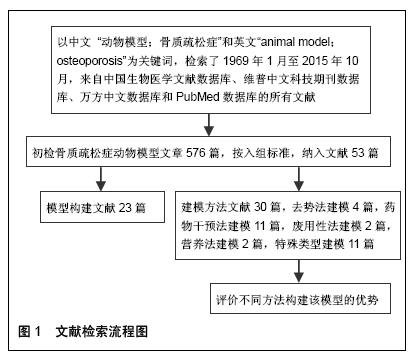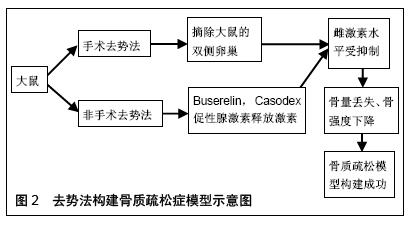| [1] Fonseca H, Moreira-Gonçalves D, Coriolano HJ, et al. Bone quality: the determinants of bone strength and fragility. Sports Med. 2014;44(1):37-53.
[2] Rachner TD, Khosla S, Hofbauer LC. Osteoporosis: now and the future.Lancet, 2011;377:1276-1287.
[3] Rodgers JB, Monier-Faugere MC, Malluche H. Animal models for the study of bone loss after cessation of ovarian function. Bone. 1993;14(3):369-377.
[4] Pavlos PL, Theodoros TX, Sofia ET. The laboratory rat as an animal model for osteoporosis research. Comp Med. 2008; 58(5):424-430.
[5] Jilka RL. The relevance of mouse models for investigating age-related bone loss in humans. J Gerontol A Biol Sci Med Sci. 2013;68(10):1209-1217.
[6] Costa LA, Lopes BF, Lanis AB, et al. Bone demineralization in the lumbar spine of dogs submitted to prednisone therapy. J Ver Pharmacol Ther. 2010;33(6):583-586.
[7] Havill LM, Levine SM, Newman DE, et al. Osteopenia and osteoporosis in adult baboons (Papio hamadryas). J Med Primatol. 2008;37(3):146-153.
[8] Scholz-Ahrens KE, Delling G, Stampa B, et al. Glucocorticosteroid- induced osteoporosis in adult primiparous Gottingen miniature pigs: effects on bone mineral and mineral metabolism. Am J Physiol Endocrinol Metab. 2007; 293(1):E385-E395.
[9] Reinwald S, Burr D. Review of nonprimate, large animal models for osteoporosis research.J Bone Miner Res. 2008; 23(9):1353-1368.
[10] 虞惊涛,马信龙,马剑雄.骨质疏松动物模型评价方法[J].中华骨质疏松和骨矿盐疾病杂志,2014,(1):66-70.
[11] Matsushita?M, ?Tsuboyama?T, Kasai?R,? et?al.? Age-related?changes?in?bone?mass?in?the?senescence-accelerated?mouse (SAM).?SAM-R/3 ?and?SAM-P/6? as?new?murine?models?for?senile?osteoporosis. ?Am? J Pathol. 1986;125(2):276-283.
[12] Cheng M, Wang Q, Fan Y, et al. A traditional chinese herbal preparation, er-zhi-wan, prevent ovariectomy-induced osteoporosis in rats. J Ethnopharmacol. 2011;138(2):279-285.
[13] Lucinda LMF, Vieira BJ, Oliveira TT, et al. Evidences of osteoporosis improvement in wistar rats treated with ginkgo biloba extract: a histomorphometric study of mandible and femur. Fitoterapia. 2010;81(8):982-987.
[14] Egermann M, Goldhahn J, Schneider E. Animal models for fracture treatment in osteoporosis. Osteoporos Int. 2005; 16:S129-S138.
[15] Yao W, Hadi T, Jiang YB, et al. Basic fibroblast growth factor improves trabecular bone connectivity and bone strength in the lumbar vertebral body of osteopenic rats. Osteoporos Int. 2005; 16(12):1939-1947.
[16] Mandadi K, Ramirez M, Jayaprakasha GK, et al. Citrus bioactive compounds improve bone quality and plasma antioxidant activity in orchidectomized rats. Phytomedicine. 2009;16(6-7): 513-520.
[17] Sigrist IM, Gerhardt C, Alini M, et al. The long-term effects of ovariectomy on bone metabolism in sheep. J Bone Miner Metab. 2007;25(1):28-35.
[18] Chiang S, Liao J, Pan T. Effect of bioactive compounds in lactobacilli-fermented soy skim milk on femoral bone microstructure of aging mice. J Sci Food Agric. 2012;92(2): 328-335.
[19] Shimizu M, Tsuboyama T. animal models for bone and joint disease. Genetic analysis of low bmd in samp6 mice. Clin Calcium. 2011;21(2):209-216.
[20] Motyl KJ, Mccabe LR. Leptin treatment prevents type i diabetic marrow adiposity but not one loss in mice. J Cell Physiol. 2009; 218(2):376-384.
[21] Stoker NG, Epker BN. Age changes in endosteal bone remodeling and balance in rabbit. J Dent Res. 1971;50(6):1570.
[22] Castaneda S, Calvo E, Largo R, et al. Characterization of a new experimental model of osteoporosis in rabbits. J Bone Miner Metab. 2008;26(1):53-59.
[23] Baofeng L, Zhi Y, Bei C, et al. Characterization of a rabbit osteoporosis model induced by ovariectomy and glucocorticoid. Acta Orthop. 2010;81(3):396-401.
[24] Saville PD. Changes in skeletal mass and fragility with castration in the rat: a model of osteoporosis. J Am Geriatr Soc. 1969;17(2): 155-166.
[25] Peng ZQ, Väänänen HK, Zhang HX, et al. Long-term effects of ovariectomy on the mechanical properties and chemical composition of rat bone. Bone. 1997;20(3):207-212.
[26] 郭峰,?李正南,?刘晋平,?等.?六月龄大鼠去卵巢后建立骨质疏松症模型的可行性[J].?中国组织工程研究,?2012,?16(24):4459-4462.
[27] Egermann M, Goldhahn J, Schneider E. Animal models for fracture treatment in osteoporosis. Osteoporos Int. 2005;16: 129-138.
[28] Weinstein RS, Jilka RL, Parfitt AM, et al. Inhibition of osteoblastogenesis and promotion of apoptosis of osteoblasts and osteocytes by glucocorticoids. Potential mechanisms of their deleterious effects on bone. J Clin Invest. 1998;102(2):274-282.
[29] Parfitt AM, Villanueva AR, Foldes J, et al. Relations between histologic indices of bone formation: implications for the pathogenesis of spinal osteoporosis. J Bone Miner Res. 1995;10(3):466-473.
[30] Rizzoli R, Biver E. Glucocorticoid-induced osteoporosis: who to treat with what agent? Nat Rev Rheumatol. 2015;11(2):98-109.
[31] Xia X, Kar R, Gluhak-Heinrich J, et al. Glucocorticoid-induced autophagy in osteocytes. J Bone Miner Res. 2010;25(11): 2479-2488.
[32] Oršoli? N, Golu?a E, Diki? D, et al. Role of flavonoids on oxidative stress and mineral contents in the retinoic acid-induced bone loss model of rat. Eur J Nutr. 2014;53(5):1217-1227.
[33] Allen SP, Maden M, Price JS. A role for retinoic acid in regulating the regeneration of deer antlers. Dev Biol. 2002;251(2):409-423.
[34] 刘和娣,李星海,佟晓旭,等.地塞米松与维甲酸致大鼠骨质疏松动物模型的比较[J].中国病理生理杂志,2004,20(4):697-699.
[35] Ponnapakkam T, Katikaneni R, Nichols T, et al. Prevention of chemotherapy-induced osteoporosis by cyclophosphamide with a long-acting form of parathyroid hormone. J Endocrinol Invest. 2011;34(11):392-397.
[36] Jeremiah MP, Unwin BK, Greenawald MH, et al. Diagnosis and Management of Osteoporosis. Am Fam Physician. 2015;92(4): 261-268.
[37] 李杰,王义生,李月白,等.乙醇对骨髓基质细胞增殖及分化的影响[J].中国骨质疏松杂志,2004,10(1)52-53.
[38] 齐振熙,王明.乙醇性骨质疏松症的动物模型研究[J].中国骨伤, 2005,18(12):735-736.
[39] Giangregorio L, Blimkie CJ. Skeletal adaptations to alterations in weight-bearing activity: a comparison of models of disuse osteoporosis. Sports Med. 2002;32(7):459-476.
[40] Jee WS, Ma Y. Animal models of immobilization osteopenia. Morphologie. 1999;83(261):25-34.
[41] Martín Jiménez JA, Consuegra Moya B, Martín Jiménez MT. Nutritional factors in preventing osteoporosis. Nutr Hosp. 2015; 32 Suppl 1:49-55.
[42] Omi N, Ezawa I. Animal models for bone and joint disease. Low calcium diet-induced rat model of osteoporosi. Clin Calcium. 2011;21(2):173-180.
[43] Kanzaki S, Ito M, Takada Y, et al. Resorption of auditory ossicles and hearing loss in mice lacking osteoprotegerin. Bone. 2006; 39(2):414-419.
[44] Geoffroy V, Kneissel M, Fournier B, et al. High bone resorption in adult aging transgenic mice overexpressing cbfa1/runx2 in cells of the osteoblastic lineage. Mol Cell Biol. 2002;22(17):6222-6233.
[45] Sekiya H, Murakami T, Saito A, et al. Effects of the bisphosphonate risedronate on osteopenia in OASIS-deficient mice. J Bone Miner Metab. 2010;28(4):384-394.
[46] Suzuki H, Amizuka N, Oda K, et al. Histological and elemental analyses of impaired bone mineralization in klotho-deficient mice. J Anat. 2008;212(3):275-285.
[47] Enomoto T, Furuya Y, Tomimori Y, et al. Establishment of a new murine model of hypercalcemia with anorexia by overexpression of soluble receptor activator of NF-kappaB ligand using an adenovirus vector. J Bone Miner Metab. 2011;29(4):414-421.
[48] Price C, Herman BC, Lufkin T, et al. Genetic variation in bone growth patterns defines adult mouse bone fragility. J Bone Miner Res. 2005;20(11):1983-1991.
[49] Seeman E. Reduced bone formation and increased bone resorption: rational targets for the treatment of osteoporosis. Osteoporos Int. 2003;14 Suppl 3:S2-S8.
[50] Ferguson VL, Ayers RA, Bateman TA, et al. Bone development and age-related bone loss in male C57BL/6J mice. Bone. 2003;33(3):387-398.
[51] 刘锡仪,刘浩宇.大鼠脑源性骨质疏松动物模型[J].中国骨质疏松杂志,2008,14(3):143-147.
[52] Oheim R, Beil FT, Köhne T, et al. Sheep model for osteoporosis: sustainability and biomechanical relevance of low turnover osteoporosis induced by hypothalamic-pituitary disconnection. J Orthop Res. 2013;31(7):1067-1074.
[53] Castiglioni S, Cazzaniga A, Albisetti W, et al. Magnesium and osteoporosis: current state of knowledge and future research directions. Nutrients. 2013;5(8):3022-3033. |
.jpg)

